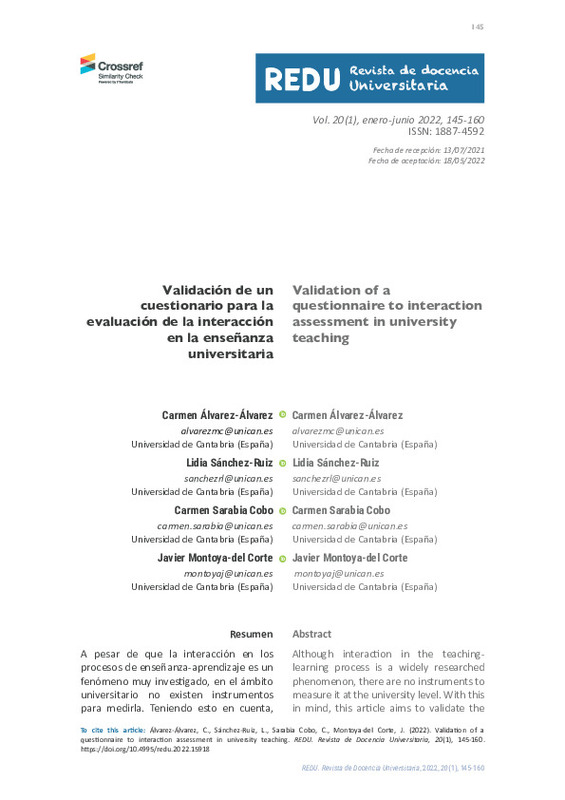Álvarez-Álvarez, C., Vejo-Sainz, R. (2017). ¿ Cómo se sitúan las escuelas españolas del medio rural ante la innovación? Un estudio exploratorio mediante entrevistas. Aula abierta, 45(1), 25-32.
Álvarez-Álvarez, C., Sánchez-Ruiz, L., Ruthven, A., Montoya, J. (2019). Innovating in University Teaching Through Classroom Interaction. Journal of Education, Innovation, and Communication, 1(1), 8–18. https://doi.org/10.34097/jeicom_1_1_1
Alves, C, Mercuri, E, Da Silva, L. (2011). Escala de Interação com Pares: construção e evidências de validade para estudantes do ensino superior. Psico-USF, 16(1), 11–21. https://doi.org/10.1590/S1413-82712011000100003
[+]
Álvarez-Álvarez, C., Vejo-Sainz, R. (2017). ¿ Cómo se sitúan las escuelas españolas del medio rural ante la innovación? Un estudio exploratorio mediante entrevistas. Aula abierta, 45(1), 25-32.
Álvarez-Álvarez, C., Sánchez-Ruiz, L., Ruthven, A., Montoya, J. (2019). Innovating in University Teaching Through Classroom Interaction. Journal of Education, Innovation, and Communication, 1(1), 8–18. https://doi.org/10.34097/jeicom_1_1_1
Alves, C, Mercuri, E, Da Silva, L. (2011). Escala de Interação com Pares: construção e evidências de validade para estudantes do ensino superior. Psico-USF, 16(1), 11–21. https://doi.org/10.1590/S1413-82712011000100003
Bai, Y, Chang, T.S. (2016). Effects of class size and attendance policy on university classroom interaction in Taiwan. Innovations in Education and Teaching International, 53(3): 316–328. https://doi.org/10.1080/14703297.2014.997776
Baudrit, A. (2012). Being a tutor of nursing students today: A sustainable and complex mission? Recherche en soins infirmiers, (4), 6-12. https://doi.org/10.3917/rsi.111.0006
Boden, K.K., Zepeda, C.D., Nokes-Malach, T.J. (2020). Achievement goals and conceptual learning: An examination of teacher talk. Journal of Educational Psychology, 112(6), 1221. https://doi.org/10.1037/edu0000421
Carr, R. (2015). Active learning: The importance of developing a comprehensive measure. Active Learning in Higher Education, 16(3), 173-186. https://doi.org/10.1177/1469787415589529
De Longhi, A.L., Ferreyra, H.A., Peme, C. (2012). La interacción comunicativa en clases de ciencias naturales. Un análisis didáctico a través de circuitos discursivos. Revista Eureka sobre enseñanza y divulgación de las ciencias, 9(2), 178-195.
Duschl, R., Osborne, J. (2002). Supporting and Promoting Argumentation Discourse in Science Education. Studies in Science Education, 38(1), 39-72. https://doi.org/10.1080/03057260208560187
Dwyer, T. (2015). Persistence in higher education through student–faculty interactions in the classroom of a commuter institution. Innovations in Education and Teaching International, 54(4), 325-334. https://doi.org/10.1080/14703297.2015.1112297
Fusco, E. (2012) Effective Questioning Strategies in the Classroom: A Step-by-Step Approach to Engaged Thinking and Learning, K-8. New York: Teachers College Press.
Gauci, S.A., Dantas, A.M., Williams, D.A., Kemm, R.E. (2009). Promoting student-centered active learning in lectures with a personal response system. Advances in Physiology Education, 33(1), 60-71. https://doi.org/10.1152/advan.00109.2007
Hartikainen, S., Rintala, H., Pylväs, L., Nokelainen, P. (2019). The concept of active learning and the measurement of learning outcomes: A review of research in engineering higher education. Education Sciences, 9(4), 276. https://doi.org/10.3390/educsci9040276
Haneda, M., Teemant, A., Sherman, B. (2016). Instructional coaching through dialogic interaction: helping a teacher to become agentive in her practice. Language and education, 31(1), 46-64. https://doi.org/10.1080/09500782.2016.1230127
Hattie, J. (2012). Visible Learning for Teachers. Maximizing impact on learning. New York: Routledge. https://doi.org/10.4324/9780203181522
Hardman, J. (2015). Tutor–student interaction in seminar teaching: Implications for professional development. Active Learning in Higher Education, 17(1), 63-76. https://doi.org/10.1177/1469787415616728
Heaslip, G., Donovan, P., Cullen, J.G. (2013). Student response systems and learner engagement in large classes. Active Learning in Higher Education, 15(1), 11-24. https://doi.org/10.1177/1469787413514648
Howe, C., Abedin, M. (2013). Classroom dialogue: a systematic review across four decades of research. Cambridge Journal of Education, 43(3), 325-356. https://doi.org/10.1080/0305764X.2013.786024
Laudadío, J., Mazzitelli, C. (2018). Adaptation and validation of the Questionnaire on Teacher Interaction in Higher Education. Interdisciplinaria, 35(1), 153-170. https://doi.org/10.16888/interd.2018.35.1.8
Majlesi, A.R., Broth, M. (2012). Emergent learnables in second language classroom interaction. Learning, Culture and Social Interaction, 1(3–4), 193-207. https://doi.org/10.1016/J.LCSI.2012.08.004
Matthews, K., Dwyer, A., Hine, L., Turner, J. (2018). Conceptions of students as partners. Higher Education, 76, 957-971. https://doi.org/10.1007/s10734-018-0257-y
McCoy, L., Pettit, R.K., Kellar, C., Morgan, C. (2018). Tracking active learning in the medical school curriculum: a learning-centered approach. Journal of medical education and curricular development, 5, https://doi.org/10.1177/2382120518765135.
Micari, M., Pazos, P. (2014). Worrying about what others think: A social-comparison concern intervention in small learning groups. Active Learning in Higher Education, 15(3), 249-262. https://doi.org/10.1177/1469787414544874
Moliní, F., Sánchez, D. (2019). To encourage the participation in class of university students and evaluate it as objectively as possible. REDU. Revista de Docencia Universitaria, 17(1), 211-227. https://doi.org/10.4995/redu.2019.10702
Orona, G.A., Li, Q., McPartlan, P., Bartek, C., Xu, D. (2022). What predicts the use of interaction-oriented pedagogies? The role of self-efficacy, motivation, and employment stability. Computers & Education, 184, 104498. https://doi.org/10.1016/j.compedu.2022.104498
Pielmeier, M., Huber, S., Seidel, T. (2018). Is teacher judgment accuracy of students’ characteristics beneficial for verbal teacher-student interactions in classroom?. Teaching and Teacher Education, 76, 255-266. https://doi.org/10.1016/j.tate.2018.01.002
Roberts, D. (2019). Higher education lectures: From passive to active learning via imagery? Active Learning in Higher Education, 20(1), 63-77. https://doi.org/10.1177/1469787417731198
Rubie-Davies, C.M. (2007). Classroom interactions: Exploring the practices of high- and low-expectation teachers. British Journal of Educational psychology, 77(2), 289-306. https://doi.org/10.1348/000709906X101601
Scott, P.H., Mortimer, E.F., Aguiar, O.G. (2006). The tension between authoritative and dialogic discourse: A fundamental characteristic of meaning making interactions in high school. Science Education, 90(4), 605-631. https://doi.org/10.1002/sce.20131
Steen-Utheima, A., Wittekb, A.L. (2017). Dialogic feedback and potentialities for student learning. Learning, Culture and Social Interaction, 15, 18-30. https://doi.org/10.1016/j.lcsi.2017.06.002
Stockero, S.L., Rupnow, R.L., Pascoe, A.E. (2017). Learning to notice important student mathematical thinking in complex classroom interactions. Teaching and Teacher Education, 63, 384-395. https://doi.org/10.1016/j.tate.2017.01.006
Tronchoni, H., Izquierdo, C., Anguera, M.T. (2018). Interacción participativa en las clases magistrales: fundamentación y construcción de un instrumento de observación. Publicaciones, 48(1), 81-108. https://doi.org/10.30827/publicaciones.v48i1.7331
Tan, Y.J., Gwendoline, C.L., Fulmer, G. (2019). Validation of Classroom Teacher Interaction Skills Scale. Asia-Pacific Education Review, 28(5), 429-446. https://doi.org/10.1007/s40299-019-00444-6
Vercellotti, M.L. (2018). Do interactive learning spaces increase student achievement? A comparison of classroom context. Active Learning in Higher Education, 19(3), 197-210. https://doi.org/10.1177/1469787417735606
Wells, G. (1999). Dialogic inquiry: Towards a socio-cultural practice and theory of education. UK: Oxford University Press. https://doi.org/10.1017/CBO9780511605895
Wong, W.H., Chapman, E. (2022). Student satisfaction and interaction in higher education. Higher Education, 1-22. https://doi.org/10.1007/s10734-022-00874-0
[-]









